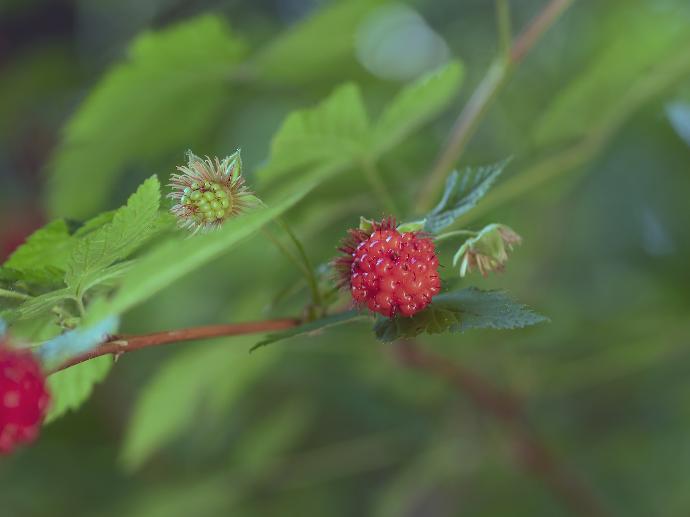Salmonberry
Salmonberry shrubs, 4-8 feet tall in Zones 5-9, exhibit fast growth in well-drained soil and full sun to partial shade. Known for their yellow to red berries, salmonberries are edible and appreciated for their unique flavor.

Habit
Shrub
Height
1-4 m
Growth
Fast
Soil
Well-drained loamy
Shade
Full sun to partial shade
Moisture
Moderate
Edible
Yes
Medicinal
Yes
Origin
North America
Climatic Condition
Temperate, Cool Climate
Temperature (°)
5-20°C
Humidity (%)
50-80%
Potting media
Peat, compost
Fertilizers
Organic, compost
Watering
Regular
Plant Weight
10-50 g
Flowering Time
Spring to Summer
Soil Ph level
5.5 - 7.5
Water Ph level
5.5 - 7.5
Soil EC
1-2 dS/m
Yield Per Plant
2-4 kg/plant
NPK ratio
10:10:10
life Span
Perennial
Health Benefits
Rich in antioxidants, vitamin C
Suggested Grow Media or Potting Mix ?
50% loam, 25% compost, 25% sand
Suggested Fertigation/Fertilizers
Fertilize every 6 weeks with a balanced fertilizer.
Common Diseases and Remedies
Rust , fruit rot
Pustules can be orange, yellow, brown, black or white appear on the fruit and leaves , dark brown lesions turn into black on fruits
Pinch off rust infected leaves and remove them from the plant.
HEALTH BENEFITS
1. High in antioxidants and vitamin C.
2. Beneficial for skin, immunity, and digestive health.
What Is An Salmonberry?
Salmonberry is a sturdy tree 10 to 12 feet tall, a non-biennial annual, with a woody trunk covered with small spines. The stems are not densely packed with thorns like other popular products, making harvesting more enjoyable.

What Are The Different Types Of Salmonberry?
1. Blackberry
A member of the rose family (Rosaceae) and is quite similar to a raspberry in size and shape; except in contrast, it's fruit colour is Black.
2. Loganberry
A member of the rose family (Rosaceae) and is quite similar to a raspberry in size and shape; except in contrast, it's fruit colour is Red.
3. Marionberry
This variety has fringed, curly leaves and a milder flavor than other varieties.

How To Care For Salmonberry?
1. Location
Salmonberry prefers deep and shallow water. Especially if it is a potted plant, it should be soaked in 1 liter of water at a time. The pot will take less water and the soil will dry out faster. Water every 3-5 days in a cool place.
2. Sunshine
Full sun or partial shade (6-8 hours of sunlight)
3. Soil
Mulberries are not selective about soil as long as it is slightly acidic and well-drained. The ideal soil pH is 5; 5 - 7.
4. Hydration
Make sure the soil is clean to retain moisture and reduce weeds, especially during the growing and dry seasons.

5. Nourishment
Feed your salmon with a balanced fertilizer in the spring before new growth appears. Follow the instructions on the fertilizer package to determine the correct application rate.
6. Issues
Hawthorn bushes can become very aggressive once established. In areas that receive a lot of sunlight, seeds will dry out and die if the soil is not moist. Buds near the base of the stem or root tip can regenerate severely damaged plants.
What Are The Benefits Of Salmonberry
They increase the risk of diseases such as cancer, heart disease, and Alzheimer's disease. Eating salmon can help fight diseases in the long run. Antioxidants are nutrients that protect the body from oxidative cell damage. Without these antioxidants, free radicals can damage the brain.

FAQs About Growing Salmonberry
1. When is the best time to farm salmon?
Salmonberry bushes are best planted in late or early spring when the soil is moist and temperatures are moderate.
2. What soil does salmonberry prefer?
Well-drained, acidic soil with a pH of 5.5 to 7.0, like salmonberry. Adding organic matter such as compost will improve soil quality.
3. How much bright sun does a salmonberry plant need?
Salmonberry fruit prefers partial shade to full sun. It tolerates some shade, but produces more fruit in full sun.
4. How much water do salmonberries need?
Salmonberry fruits need regular watering, especially in dry conditions. Keep the soil moist but not waterlogged.
5. Should salmonberries be pruned?
Yes, salmonberries benefit from annual pruning to remove dead and diseased wood, improve air quality, and promote fruit production. I am receiving it.

